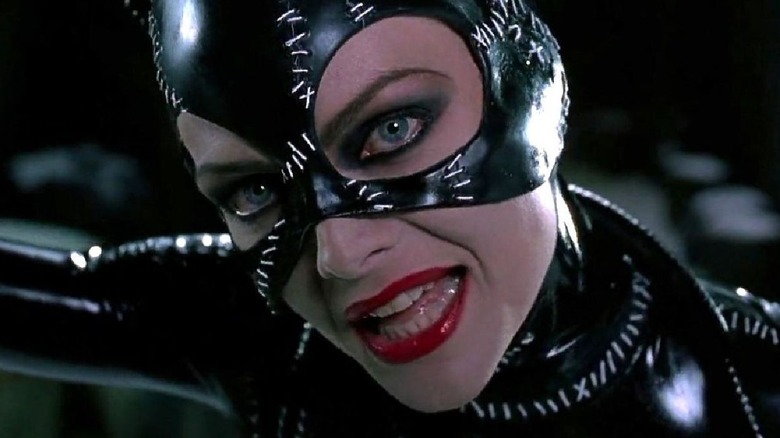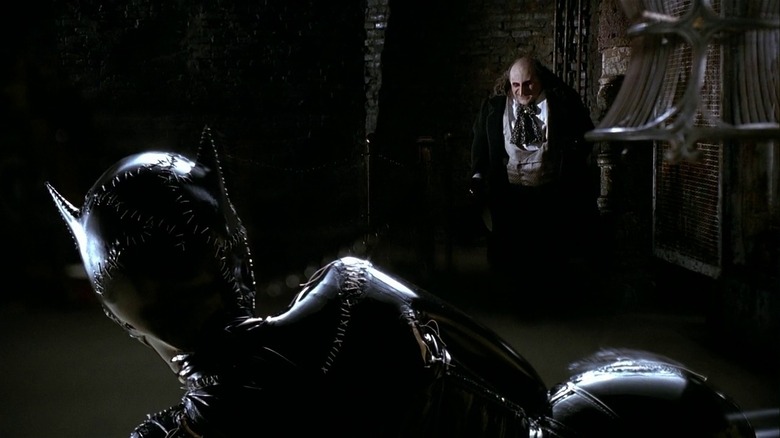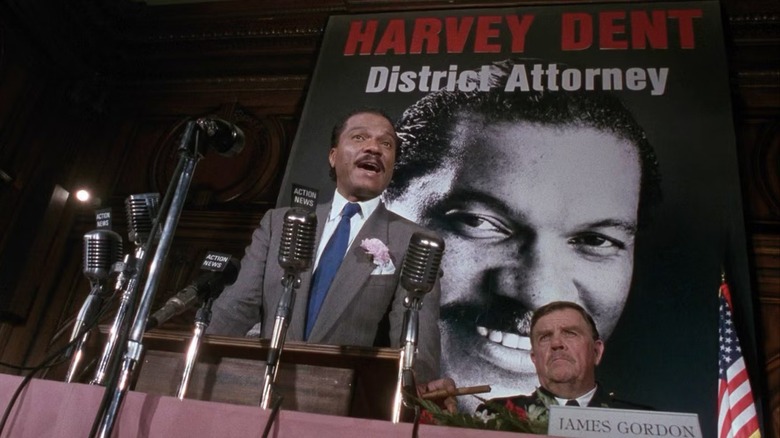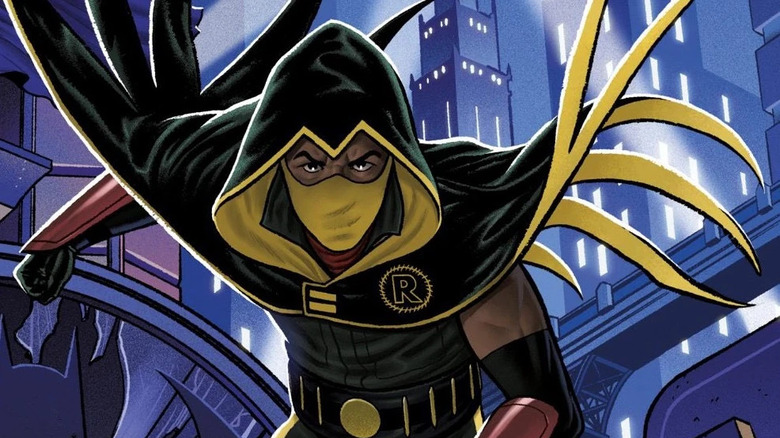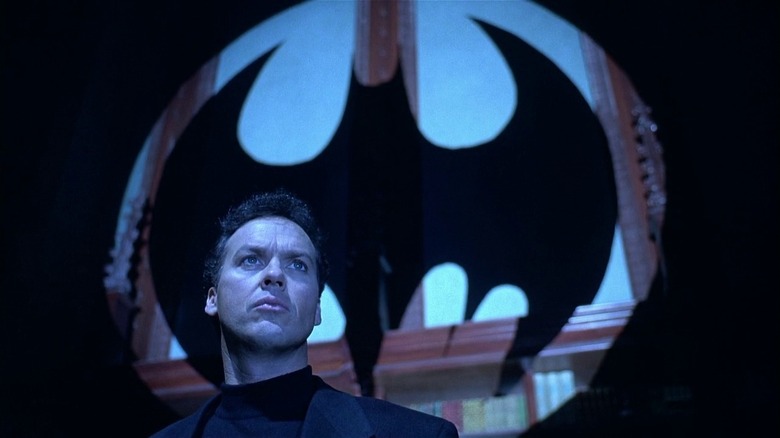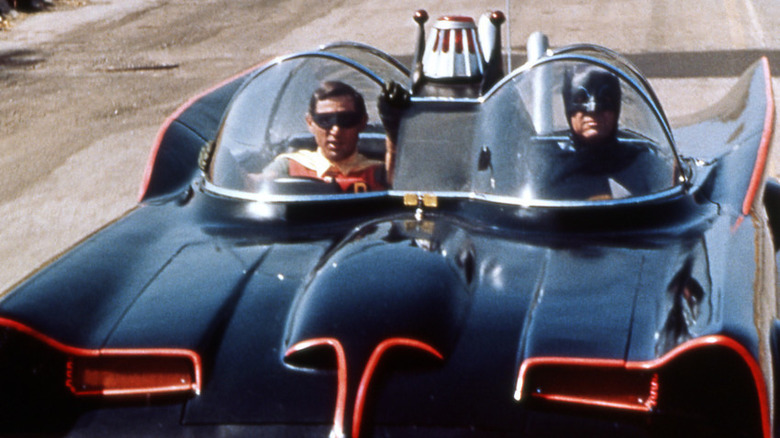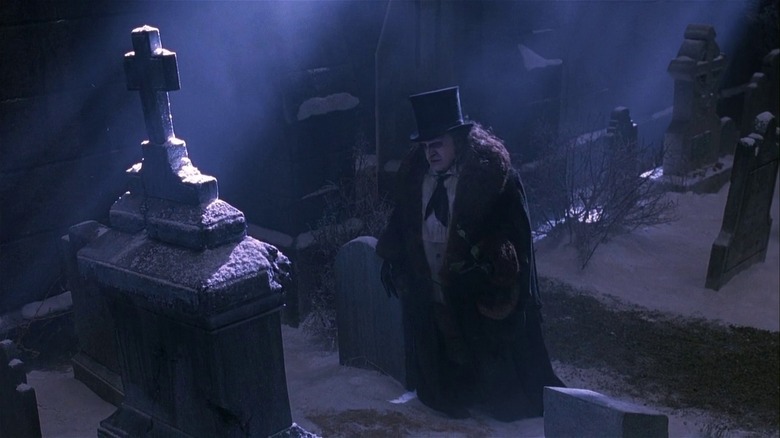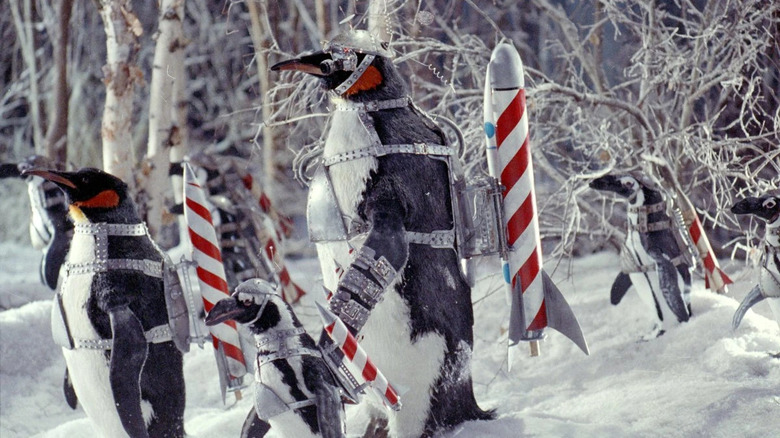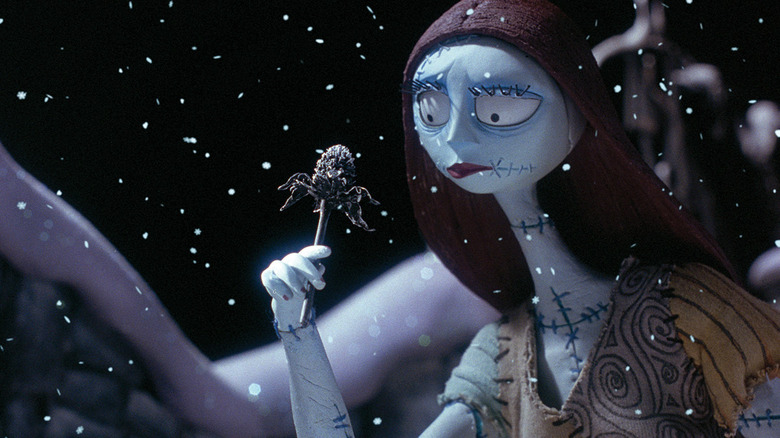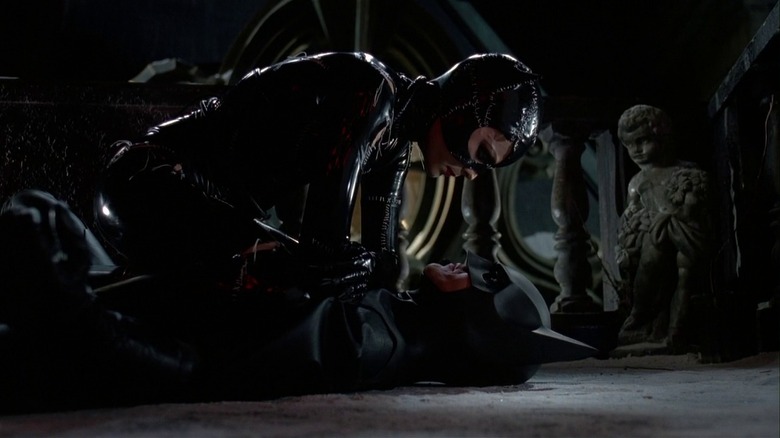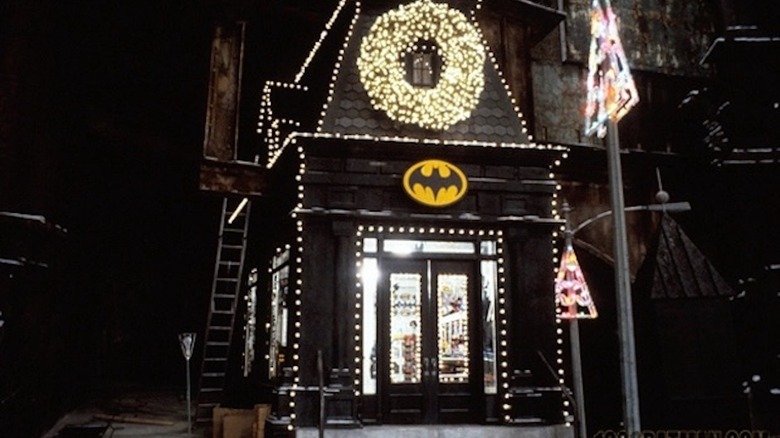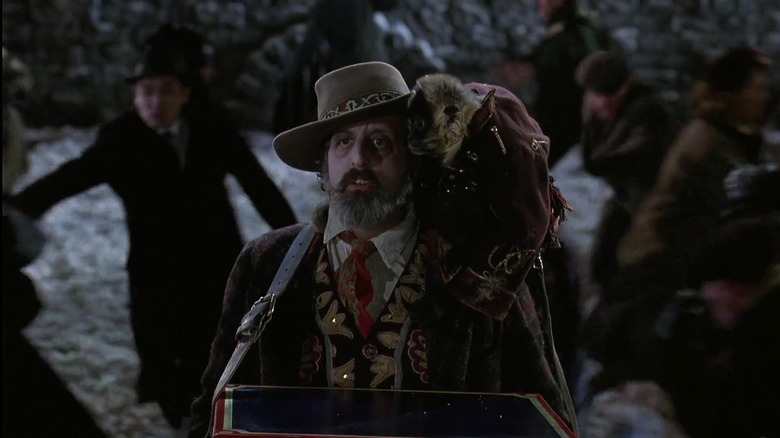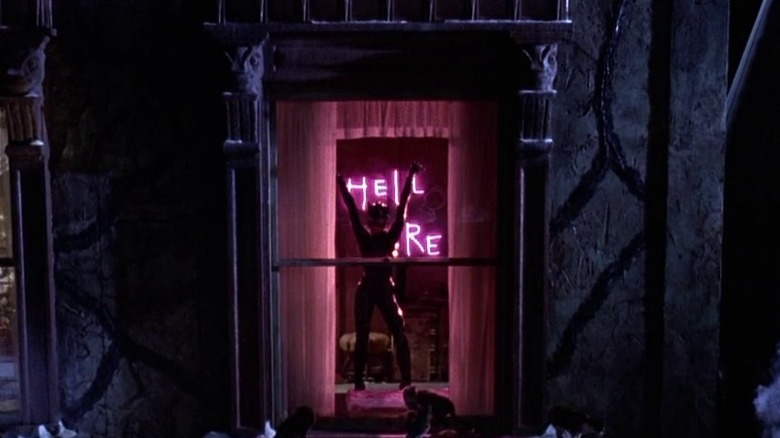Behind-The-Scenes Secrets From Batman Returns
The first half of Tim Burton's career can sometimes seem like an elaborate prank on Hollywood. Here this man was, churning out the most unexpectedly dark, deeply personal, loosely structured, and, above all, weird movies. They seemed designed to be as uncommercial as possible, and yet the audience ate them up to the tune of hundreds of millions of dollars. Somehow, it even worked when he got the reins of the "Batman" franchise and his usual parade of freak-show spectacle became a record-breaking hit.
So maybe it's not so shocking that Warner Brothers was willing to let Burton do whatever he wanted with the sequel. The result was even weirder, less commercial, and more all-around Burton-y than before. The world's most recognizable superhero became the center of a movie that bears only a passing resemblance to any of his million other incarnations — a bleak nightmare full of sexual fetishes and cynical politics, where the freakish villains have more in common with the hero than anyone else.
The gamble didn't paid off, however, and the studio gently asked Burton not to come back for Batman's next outing. Now that the superhero movie formula Burton helped create has been refined and ruthlessly adhered to, "Batman Returns" seems like a minor miracle. How did Warners agree to let one of their most beloved and popular characters star in this fantasia of subversion and perversion? There's no simple answer, but we can at least give you some surprising stories about how it got there.
The first script was almost unrecognizable
"Batman Returns," like "Batman," began with a script from Sam Hamm. As Den of Geek reports, that script featured Batman, Catwoman, and the Penguin — but there the similarities end.
The filmed "Batman Returns" takes place in an alternate universe of dream logic and cartoon violence, whereas Hamm envisioned Batman tackling the very real problem of homelessness and gentrification. On the other hand, the main plot was even cartoonier than it eventually became, with Catwoman and the Penguin bumping off Gotham's rich and famous to find seven golden ravens, which would lead them to a secret treasure that had been in the Batcave the whole time without the world's greatest detective ever noticing. Meanwhile, the focus was much tighter on the title character than in Tim Burton's eventual ensemble piece, as he uncovers Wayne family secrets and determines to never kill his enemies again.
A few aspects of "Batman Returns" are visible in Hamm's script: He came up with the Christmastime setting and laid the groundwork for Burton and Michelle Pfeiffer's radical reimaging of Catwoman with a description of her costume as "bondage gear." But Burton wasn't interested in the rest, so according to the documentary "Dark Side of the Knight," the studio finally got him on board by encouraging him not to make another Batman movie but "a Tim Burton movie." And that's what they got, for good and for bad.
An early draft was an origin story for Two-Face
On the way to hammering "Batman Returns" into its current shape, replacement screenwriter Daniel Waters planned on squeezing a third supervillain origin in between those of Catwoman and the Penguin. Den of Geek reports that the character who would eventually become Max Shreck (Christopher Walken) was originally written for Billy Dee Williams to return as District Attorney Harvey Dent. It makes sense that a high-ranking legal official could play the same role as Walken's captain of industry — if anything, he'd fit more smoothly into the election subplot than the Penguin does. If you remember the climax, where Catwoman kills Shreck with an electrified kiss, it's easy to see how, instead of killing him, it could have left him with the half-scarred visage of the comics' Two-Face.
Instead, when Harvey Dent returned to the screen in "Batman Forever," he'd apparently bleached his skin and shaved off his mustache, because he'd turned into Tommy Lee Jones. Williams would have to wait decades to get the role he signed up for, first with a voice cameo in "The Lego Batman Movie," and then when Hamm and artist Joe Quinones used his likeness to reimagine Two-Face's origin in the Burtonverse for the "Batman '89" comics series.
Burton couldn't figure out how to work Robin in
In addition to characters like the Penguin, Catwoman, and Max Schreck, early drafts of "Batman Returns" also tried to pack in yet another origin story, for Batman's faithful sidekick Robin. Waters and Burton hashed out multiple ideas for how to write him in, including a radical reworking where he would have been an adult mechanic played by Marlon Wayans (still with the "R" emblem, as part of his uniform coveralls).
Burton admitted in "Dark Side of the Knight" that he finally decided to kick the can down the road: "At this point, I think Warners saw it as this potentially ongoing thing, maybe," he explained. "So there was always this, 'You know, if we don't do it in this one, we'll do it in the next one' kind of deal." And that was exactly what happened, without Burton, when Joel Schumacher cast Chris O'Donnell as the Boy Wonder in "Batman Forever" (Wayans, meanwhile, was still collecting residual checks as late as 2009 for a role he was contracted for but never played).
The Robin question may have influenced another major part of "Batman Returns," however: The Penguin travels with a gang of circus performers, something that had never been part of his comics interpretation. But it was a major part of Robin's, as a child acrobat who joins forces with Batman after his parents are shot off their trapezes.
Michael Keaton insisted on fewer lines
It's difficult to overstate how unusual Burton's level of creative control on "Batman Returns" was. Any movie except the very cheapest requires coordinating your vision with dozens of collaborators. On a production the size of "Batman Returns," that number can go into the thousands. But not only did Burton say in "Dark Side of the Knight" that the producers more or less left him alone, he managed to assemble a cast that saw the movie just as he did.
Countless directors have stories of their stars demanding changes to the script to expand their roles. But Michael Keaton felt just the opposite about playing Batman: He may be the only actor in history to demand fewer lines. He saw Batman as a mysterious, shadowy figure and didn't want to let viewers get too far inside his head. Daniel Waters told The Hollywood Reporter, "Michael Keaton would go through the script and say, 'Hey, that's a great line, but you gotta cut it. This is a good speech, but you gotta take it out.' He wanted to have very minimal dialogue, especially in the Batsuit. When I saw the final film, I realized he was exactly right."
Keaton once drove to the set in the original Batmobile
Even though "Batman Returns" takes a hammer to Batman's existing image, it was still done by some of the biggest Bat-fans you could ever hope to meet. According to Empire (via Gorgeous Pfeiffer), Michael Keaton got a surprise visit on the set from the classic Batmobile that Adam West drove in the '60s TV show. Empire described Keaton's "almost childlike excitement" as he ran out to see the machine he'd grown up with on TV.
Empire reported that Keaton's stunt double David Lea had managed to get hold of the car as a prank, but the timing suggested more of a publicity stunt. Either way, it's easy to believe Keaton's excitement was genuine as he asked Lea to drive him from his trailer to the set. But he didn't get to hog all the fun — Burton demanded a ride too. It wouldn't be the first time the director crossed paths with the famed vehicle: when he made his debut feature, "Pee Wee's Big Adventure," he made sure to include the classic Batmobile in Pee Wee's visit to the Warner Bros. backlot.
Danny DeVito got a painting from Burton he never parts with
One of the most radical reworkings in "Batman Returns" is the origin of the Penguin, who's turned from a merely funny-looking mob boss to one of Burton's classic tragic freaks: abandoned in infancy for his deformity and raised by penguins in the Gotham sewers, before getting picked up for the Red Triangle Circus's sideshow.
A former animator, Burton likes to work through his ideas visually, and he sold Danny DeVito on this version of the Penguin with a painting depicting a sad little boy with dark eyes and wing-like stubs for hands, and the text, "My name is Jimmy, but my friends call me the hideous penguin boy." DeVito described it to The Hollywood Reporter, adding, "I'm staring at it right now. I carry it around with me wherever I go." He never specifies just what he means by "everywhere," but the image of Danny DeVito moving house or showing up to all his meetings with a painting tucked under one arm is too hilarious not at least hope it could be true.
Prima donna penguins demanded Antarctic temperatures
They say never to work with children or animals. The "Batman Returns" set may have been light on children, but it's a perfect example of just how challenging live animals can be. Oswald Cobblepot's army of penguins were far from their Antarctic home, and keeping them safe and healthy meant transporting the Antarctic to Los Angeles. Christopher Walken described the penguins' deluxe accommodations to The Hollywood Reporter: "They had their own area on the studio lot with a swimming pool and refrigerated dressing rooms."
"It was cold as s*** because we had real penguins and they had to keep the water really cold," Danny DeVito added. "They had these massive air conditioners. I was the only one really comfortable, because I had pounds and pounds of face prosthetics and the body padding, not to mention the heavy coat." In "Dark Side of the Knight," Burton remembered the surreal experience of walking off the set in winter gear and into the 100-degree L.A. summer sun.
Like any prima donnas, some of the penguins could be difficult on the set. They weren't all bad: Walken remembered the emperor penguins as being very friendly, saying, "They would walk up to you and you could pet them like a cat." But the littler the penguins were, the nastier they got: "The smallest ones were very busy and aggressive, they'd give you a peck."
Catwoman's costume cross-pollinated with The Nightmare Before Christmas
One of the most striking images in "Batman Returns" is Burton and designer Paul Barrett-Brown's overhaul of the classic Catwoman suit into a walking advertisement for latex bondage gear, barely held together by Frankenstein-ish stitches and staples.
It's not exactly kid-friendly stuff, but at the same time that he was directing Michelle Pfeiffer's white-hot performance, Burton was also producing a kids' movie, "The Nightmare Before Christmas." While he handed directing duties over to Henry Selick, "Nightmare" was at least as much a passion project for Burton, based heavily on his story treatment and sketches. But sometimes that meant the wires got crossed.
One of the central characters in "Nightmare" is Sally, a Frankenstein — sorry, Finkelstein — monster whose stitches keep coming loose, just as Catwoman's outfit get progressively shredded over the course of "Batman Returns." The director admitted in "Burton on Burton" that both characters share a common origin, but more for personal reasons than laziness: "I was into stitching from the whole Catwoman thing, I was into that whole psychological thing of being pieced together ... The feeling of being loosely stitched together and constantly trying to pull yourself together, so to speak." Ironically, no less an authority than Santa Claus pegs Sally as the most "together" person in Halloweentown, while Catwoman tragically never stops coming apart at the seams.
It was no picnic getting the Catwoman suit that tight
The Catwoman costume has no doubt been responsible for more than one erotic fantasy, but it was a lot less fun to wear than it is to watch. In the movie, it's a quick-and-dirty DIY job, and the ragged stitching makes it easy to believe (how Selina got all that material from one little jacket, not so much). But in reality, it was an expensive, and painful, piece of machinery. Empire estimated the cost at $1000, multiplied by the 60 different suits Pfeiffer went through over the course of the shoot. If Pfeiffer was tough on the costumes, the costumes were tougher on her. She got right to the point with The Hollywood Reporter: "It was the most uncomfortable costume I've ever been in."
She went on to explain why: "They had to powder me down, help me inside and then vacuum-pack the suit... I had those claws, and I was always catching them in things. The face mask was smashing my face and choking me." Pfeiffer added that the costume originally did not offer her a way to go to the bathroom either. They at least fixed that last one, but we have to imagine the rest of the Catwoman experience goes a long way to explaining why Pfeiffer never returned to the role.
Penguin attacking a Batman store never made the final cut
As noted earlier, the studio pretty much left Burton alone on "Batman Returns." This probably explains how the film made it to theaters despite its wide subversive streak — after all, the real monster isn't the monstrous supervillains but Max Schreck, the upstanding department store magnate who proves repeatedly that he has even fewer qualms about theft and murder than the Penguin or Catwoman. Unlike them, he doesn't even have any deep-seated trauma to explain the way he is. He seems to have decided to be evil just because he can.
That anti-consumerist message must have sat uneasily with Warner Brothers, who made millions on "Batman Returns" toys and other promotional gimmicks. AFI lists, to name a few, a line of Catwoman-inspired fashion, an $8-million-dollar roller coaster at Six Flags, and 300 pop-up Batman shops.
Burton was biting the hand that fed him, and in one small way, the hand bit back. At one point, Shreck encourages the Penguin to stage a riot with his Red Triangle Gang to boost his mayoral campaign. Den of Geek revealed that one of their targets was originally a Batman store full of the kind of kitschy tchotchkes that flooded the market in real life. This was apparently too close for comfort for Burton's bosses, and one photo is all that remains of that scene. We guess the bean counters were willing to eat the cost of building and demolishing that set if it meant keeping their image clean.
DeVito had a harrowing experience with a monkey
Bats, cats, and penguins weren't the only animals the cast of "Batman Returns" had to contend with. The second-in-command of Penguin's gang is DeVito's "One Flew Over the Cuckoo's Nest" co-star Vincent Schiavelli, playing an organ grinder who comes complete with the standard monkey. That monkey gets his big star moment after Batman saves the babies Oswald had kidnapped and uses the critter to dispatch a message to his boss, on Bat-stationary: "The orphans regret they're unable to attend."
That simple scene proved a challenge for DeVito and his primate costar. DeVito said in "Dark Side of the Knight" that the scene went smoothly enough in the first rehearsal. But monkeys don't understand Method acting, and when DeVito went into Penguin mode, things went off the rails. "The monkey comes halfway down, sees me — and goes berserk!" DeVito recalled. After a few more takes, the monkey was better prepared for the Penguin, with DeVito joking, "We're really very friendly now ... we spent the last weekend at (high-end Santa Monica hotel) Shutters on the Beach!"
The McDonald's toys inspired a mass protest
With "Batman Returns," Tim Burton made a movie for himself, not for kids, with all the darkness, sex, and violence that implies. Warner Bros. tried to sell it to kids anyway, but did not get the results they wanted when the tie-in toys hit McDonald's. The backlash — or Batlash, as they called it — was big enough to get an article in Entertainment Weekly, outraged letters in the Los Angeles Times, and talk show host Faith Daniels to devote a whole episode to "Parents Against Batman." And that was one of the more measured takes. The Los Angeles Times received one letter asking, "Has McDonald's no conscience?"
Warner Bros. tried to downplay criticism by insisting the toys were promoting Batman in general, and not his latest movie incarnation, according to an anonymous spokeswoman who added, "Clearly Batman is not meant for five-year-olds. As for whether it's appropriate to Happy Meals, that's up to McDonald's. We don't tell them their business." As Entertainment Weekly pointed out, the toys could just as easily have led to the far more age-appropriate "Batman: The Animated Series," which debuted the same year. But the damage was done, and Tim Burton's "Batman 3" was a movie that no one ever saw.
